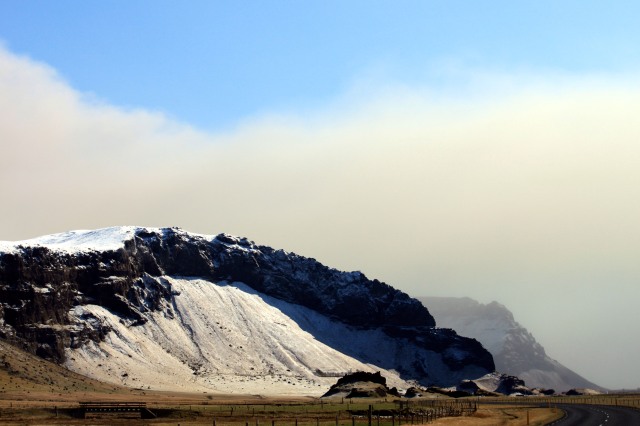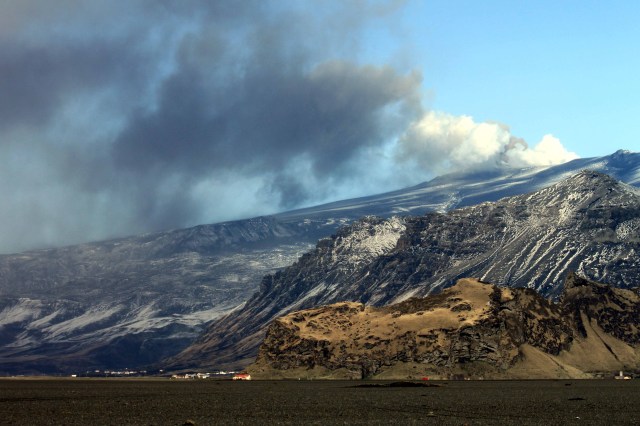Playing with fire in Iceland, Part 1: Happy Anniversary, Eyjafjallajökull

April 14th marks the anniversary of the Eyjafjallajökull eruption in Iceland. You know the one. The little ash cloud that disrupted flights across half the northern hemisphere. The one that was dubbed the worst travel disruption since 9/11.
I had booked my trip to Iceland right before Eyjafjallajökull blew. My original itinerary had included a camping and hiking excursion along the Fimmvörðuháls trail in Þórsmörk, where a volcanic fissure had opened up in mid-March 2010. Tour companies were taking visitors to see the exploding lava up close and when I had heard of the “tourist-friendly” eruption, my inner travel writer jumped on the story.
But before I could depart, Eyjafjallajökull exploded, news hit of closed airports across Europe, and I held my breath as I waited to hear the fate of my own flight. Remarkably, it went ahead; in a strange twist, Iceland’s international airport remained open during most of the disruption as the ash blew east, away from the airport on the west coast. And so, it was with a bit of surprise (and disbelief from friends back home) that I touched down at the black fields of Keflavik airport while a volcano smoked in the distance.
My plans to hike Fimmvörðuháls, however, were cancelled. The Eyjafjallajökull volcano sits under a glacier overlooking the trail, and when the eruption hit, the entire area was flooded with melted glacial water. Campers had to be airlifted out while raging rivers and chunks of ice barrelled down the mountainside.
But Icelanders are nothing if not resourceful, and despite the setback, many tour companies were considering taking groups out to the new eruption. Unlike the previous eruption that was merely a pretty show, this one was ugly and dangerous, with a global impact. Tour guides rightly suspected that visitors and armchair volcanologists would want to see the infamous smoke-belching monster for themselves. I certainly did.
And in a twist of too-good-to-be true fate, my bad timing actually worked in my favour. I contacted the Toronto Star newspaper and told them I was about to head directly into the ash, and they hired me on to write an on-the-scene piece for their foreign news section.
An island of fire
The drive from the airport to the capital of Reykjavík crosses the Reykjanes peninsula—an area of such immense bleakness that it made my heart ache. To my right, black lava fields stretched interminably into the distance and to my left, the land dropped off into the grey crashing waves of the North Atlantic. There were no trees, no grass, no bushes, just a spongy green moss growing along the hardened lava. It was eerily beautiful, like a fairytale nightmare, and my introduction to the force behind volcanoes.
There are more than 200 active volcanoes in Iceland, but none has captured the public’s eye like Eyjafjallajökull. When it first erupted, the explosive combination of hot magma and glacial water created a cloud of black ash that rained down over the countryside and spread eastward over mainland Europe.
Iceland’s south coast, once the most fertile land in the country and home for much of the farming industry, was cast into a black fog that hung for days. The melting glacier flooded the farms below and washed out sections of the national highway. For a few weeks, the area was a ghost town as residents were forced to evacuate. By the time I arrived, the area around the base of Eyjafjallajökull had just re-opened to the public. The timing of my trip meant I would be one of the first tourists allowed into the area.
Meeting the beast
I met my guide, Erling Aspelund from Iceland Encounter, at the Reykjavík bus terminal, and from there it was a three-hour drive to the base of the volcano, just past the small town of Hvolsvöller on the south coast. As we drove the highway, the cloud of smoke could be seen rising up over the mountains, alternating between white steam and sudden poofs of black ash.
As we approached, I could still see the outlines of a hazy brown fog dangling over the farmland. Just a few days prior, that haze had been a wall of blackness, impossible to see or drive through, and required eye protection and breathing masks for anyone who ventured close. The air had cleared enough that we didn’t need the masks we had brought, but it still reeked of burning tar.
At Hvolsvöller, we veered off the main highway and into the countryside. The road quickly gave way to a bumpy dirt path and series of glacial rivers, passable only by large 4×4 vehicles. Erling drove our car seamlessly into the first river, then the second, finally arching the vehicle up over the riverbank and onto the roughest road I had ever ridden on.
Arriving at the base, I watched out my window as the cloud grew darker and more ominous. The smoke and cloud cover at the summit made it impossible to see any lava, but we could hear it – as we parked and climbed out, a booming crack of what sounded like thunder shook the valley. It was the volcano releasing another burst of magma, and as we stood below it, it continued to rumble and groan.
Erling pointed to a V-shaped cut in the side of the glacier, where the water came rushing out in the first few days of the flood. Trickles continued to pour out from various holes in the side of the ice, melted by the lava flowing underneath the glacier. An emergency services crew was parked next to us, monitoring the valley in case the floodgates opened up again.
Every five years or so, a volcano somewhere on this tiny island erupts. Most of these eruptions are fairly small, but every so often one will awake with such force – like Eyjafjallajökull – it’s as if the devil is emerging from the earth’s depths.
Part 2 offers some other ways to get up close and personal with Iceland’s volcanoes.
I covered the story of Eyjafjallajökull for both the news and travel sections of the Toronto Star newspaper.






Pingback: Playing with fire in Iceland, Part II: This way to hell « AnywhereAndHere